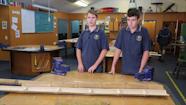Cheryl Pym explains how collaboration forms the foundation for school-wide planning in technology education.
School-wide programme planning
Transcript
I really believe that good school-wide planning in technology education starts with collaboration first and foremost, followed by shared PLD opportunities, and good pedagogical leadership.
So if we start with collaboration, to start with I think it’s really important that everybody is singing from the same page. So we have all the players in the syndicate or the faculty round the table, we have a shared understanding about what we’re trying to achieve so we know what our graduate profile in technology education looks like, what the pathway through technology is going to be about, and how we’re going to get there.
So if the digital people are teaching systems, then the food teacher might be teaching products, and we all have a shared view of which part of the curriculum our focus is going to be on, and how we can then value-add as a student moves through the school.
So when Cheryl goes to her year nine rotations, if we’re lucky enough to have four rotations, then those aren’t siloed learning experiences for Cheryl, they are a cumulative effect and by the time she comes out she’s not only got a raft of discipline, skill, and knowledge, but she has a really solid grounding of the components in technology education from the three strands. That can only happen when we all sing from the same page. We all have the same language, we all have the same understandings, we come together to talk around curriculum, and we talk about what student work looks like. We put our work on the table and we moderate between classes, between rotations and levels, and we all know what we’re trying to achieve.
The head of faculty or the head of syndicate is a really key role in providing the leadership within that sort of framework. Partly because they’ve been given that responsibility but partly because somebody has to have a vision and have a plan and work with people to create that vision in its enactment so that students are the product, if you like, if they’re going to be what used to be an industrial view of education where kids came in, and they were a sausage factory and went out the other end, what are students bringing with them, how are we working with the students to add to their knowledge and their skill base and where are they going?
The leader in technology education whether it be a syndicate leader, or head of faculty, or a head of department, has a really key role in not only developing collaboration but having a means of developing a shared vision for the faculty or syndicate so that everybody is unified in what they’re trying to achieve. So we all know what we’re doing, where we’re going, how we’re going to get there to see where students are going. So their leadership capacity is far more than the management of the nuts and bolts things and so often meetings have revolved around the paper war that takes place in a school, or how we’re going to manage our finances, when in actual fact what we need of technology leadership is that people are focussed on the professional conversations around learning, around the learning of the students but also the learning of the teachers. So that shared PLD or professional learning development is situated inside the faculty meeting and then it moves out from there so we moderate together or we co-plan together, we create learning activities and see whether these are going to work together.
And of course the prime opportunity for that is leading that into a cycle of inquiry. So teaching as inquiry can be a faculty wide event as well as individual event, allowing people to look into what they're teaching, how they're teaching it, why they’re teaching it and what impact it’s having on their students. Is it having the desired outcome, if Cheryl’s going to four rotations, is she coming out with a wealth of experiences that build together to create a technologically literate student or is she having siloed experiences where she comes out with some digital knowledge, and some food knowledge, and some graphics or DVC knowledge, or is she coming out with a raft of that plus conceptual understandings from the curriculum. So she understands what tech practice is about or the nature and knowledge of technology.
Related videos
Combining knowledge and practice (01:58)
Steve Andrew explains how understanding materials is essential for effective technological practice.
Linking hands-on experiences and understandings (03:54)
Hands-on experiences allow the students to see materials understandings in action.
Play, experiment, explore (02:55)
Steve Andrew lets the students see, feel, and play with products to develop their understandings in materials.
Finding materials to meet the specs (02:36)
Steve Andrew shares how students identify material specifications in a brief and then test materials to find those that are suitable....
School–industry relationship cuts both ways (03:36)
Steve Andrew and Terry Rillstone describe the way the relationship between St John's College and The Shop has benefits for them both....
Pushing the boundaries with materials (02:53)
Steve Andrew describes how his senior students have the confidence to select and work with unfamiliar materials.
Exploring unfamiliar materials (02:44)
Year 12 students from St John's College describe what they know about bamboo and how they are applying this knowledge to their projects....
Students and teachers talk about testing materials in year 11.
Manipulating, forming, and transforming
Students in year 10 describe manipulating, forming, and transforming materials.
Evaluating materials for an outcome
Steve Andrew and students talk about using their knowledge to test materials for their projects at year 12.
Year 10 students describe some of the attributes for the snake skates they are developing.
Senior students select their own issues
Year 12 students talk about the issues that they have selected for their projects.












